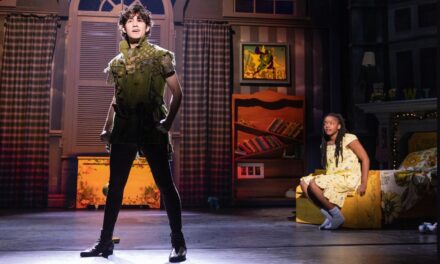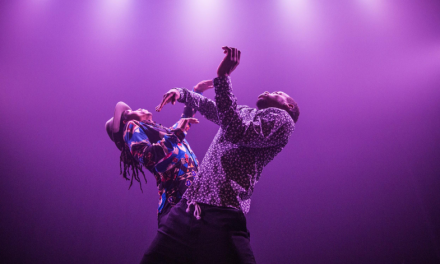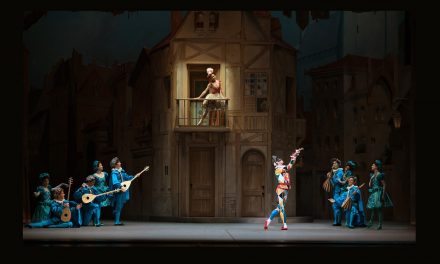“In 1942, Executive Order 9066 forced over 120,000 Japanese Americans into incarceration camps. Nearly 80,000 Black migrants transformed the vacated Little Tokyo into Bronzeville — a center for Black business, culture, and jazz. As WWII ended, the hopes for a Black and Japanese American “Little Bronze Tokyo” were never realized.”
This epigraph introduces Marissa Osato’s “to peer through veils” with a solemn gesture toward missed allyship. But there’s something hopeful in its implications as well: if not then, how about now? The piece was screened at the Japanese American Cultural & Community Center last night, presented by the JACCC and Sustainable Little Tokyo, and funded in part by the Kresge Foundation and the Andrew W. Mellon Foundation, pointing toward the “potential power of solidarity between Black and Japanese American communities in Los Angeles.”
Frames focused on performer Shiori Kamijo skip and speed backwards and forwards, giving the impression of unstable time and history. It’s a little eerie, Kamijo stepping hastily through Little Tokyo, alone at night. But the reference to communities past gives the feeling of warm, bustling nightlife, of ancestors that keep Kamijo company as she paces. The soundscape, thoughtfully and beautifully conceived by Sara Sithi-Amnuai, opens empty breaths into brass hums, laments, shouts among city noises.
The soundscape, performed by Sithi-Amnuai (trumpet), Zekkereya El-magharbel (trombone), and Will Kjeer (piano), illustrates Kamijo’s clear and impactful movement shifts even further. She spares no energy, no tiny detail. She’s clean but unbound, precisely expressive. Her acting is affecting with no need for words; communicative, but not at all campy. Her shadow is danced by Vickie Roan, and the two are so in sync that you couldn’t guess the shadow’s individuality until the choreography breaks unison – which shows just how clearly and dynamically Osato imparts each movement in her work. It’s a cut above cleanliness: it’s another layer of feeling, meaning.
As Kamijo and her shadow dialogue with Isamu Noguchi’s To the Issei (1983), a sculpture work that rests in the JACCC plaza, there’s a sense of her speaking with ancestors, but not just the Japanese residents of Little Tokyo. Jazz phrases weave in and out of Sithi-Amnuai’s score in warm tribute to the Black Bronzeville era, and she dances with them, too, in sweeping vernacular that both contrasts her other movements and compliments them effortlessly.
Osato is articulate in every way. Her choreography and direction describe the title phrase so aptly; the viewing experience brought me to understand the meaning of “peer through veils” so much more deeply – perhaps in ways that words couldn’t. The movement is well-researched and imbued with meaning, each step giving breath to a moment in this history of Black and Japanese Angelenos. She pulls from contemporary vocabulary and from rooted traditional movements, marrying the past and present with grace. She tackles those topics central to the American immigrant experience: “isolation and invisibility, shedding and assimilation, displacement and reclamation,” as listed in the program notes.
A deep and meditated collaboration between Osato and Sithi-Amnuai is evident throughout the film, each movement’s dynamic harmonizing with the full and rich soundscape in a symbiotic relationship. Each gives intention to the other. The film is a constant – but seamless – in and out. Transitions are palpable but not disjointed, particularly in the way Kamijo floats in and out of the stylized sections Osato uses to reflect Black and Japanese cultures.
The familiar JACCC plaza landmarks allowed me a feeling of presence, transportation into the whimsical world Osato built with Sithi-Amnuai. Lighting designer Margaux “Mago” Morales, an expert veteran of site-specific production in Los Angeles, and editor/DP Alex Laya no doubt contributed to the experience as well, creating the conditions for viewers to feel remnants of history through a screen experience. And as the sun rises after Kamijo’s evening of conversation with those that came before, there’s hope still for Black and Japanese solidarity to realize its power, even after all these years. The final frames read:
“So, how could I see clearly now, I who must use thick spectacles for near-sightedness, who am trying to peer through three veils, white, yellow, and black?” -Hisaye Yamamoto, “Small Talk” from the Los Angeles Tribune, Dec. 28, 1946.
Marissa Osato’s to peer through veils is available to rent through June 30, HERE.
To visit Marissa Osato’s website, click HERE.
To visit the Japanese American Cultural & Community Center website, click HERE.
Written by Celine Kiner for LA Dance Chronicle.
Feature image: to peer through veils – Marissa Osato – Photo by Scott Oshima








